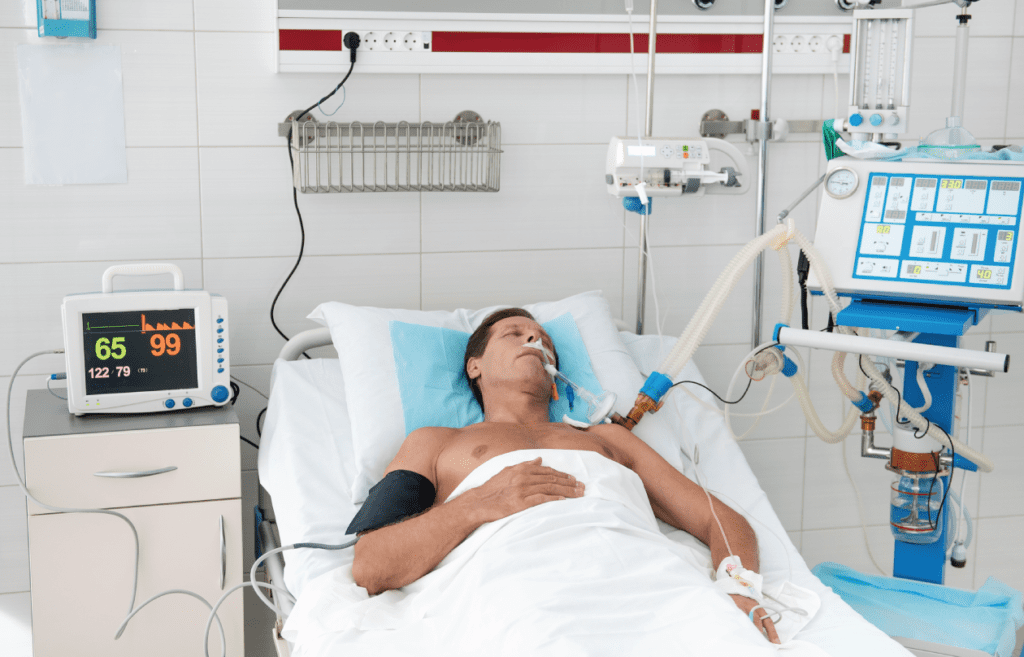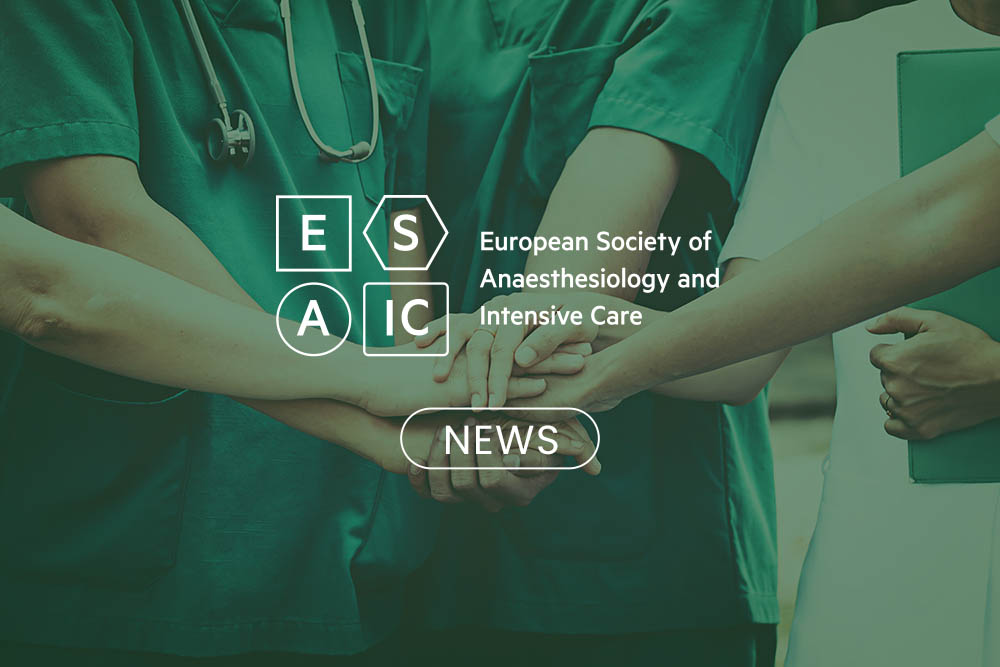Newsletter 2020
PROBESE trial: Open up your PEEP mindset

Dr R Mellado Artigas MD, EDAIC, EDIC.
Dr M Giménez-Milà MD, EDAIC, EDIC
rmartigas@gmail.com
Protective ventilation is a cornerstone in the management of patients with acute respiratory distress syndrome (ARDS) in the ICU. In the last decade, we have seen physiological evidence showing that protective ventilation also confers benefit to patients in the operating room (OR)(1–4). Importantly, a trial carried out by Futier et al. showed that when protective ventilation was compared to non-protective ventilation in patients at high risk of presenting postoperative pulmonary complications (PPC), the intervention group presented with less PPCs, reduced need for reintubation and displayed a shorter hospital stay(5).
Protective ventilation includes the usage of low-tidal volume (between 6 to 8 mL/kg predicted body weight (PBW)), plateau pressures below 28-30 cm of water, and the addition of a certain amount of positive end-expiratory pressure (PEEP). While low-tidal ventilation reduces the amount of distension (and its accompanying distending pressure) that the alveoli presents at each breath with the goal of reducing ventilator-induced lung injury (VILI), PEEP reduces atelectasis and prevents airway closure and subsequent reopening during tidal inflation; which is also known to be harmful.
However, this “certain amount” of PEEP or, in other words, how to set it precisely is at the core of endless research with studies showing inconclusive results. Two approaches could be considered in terms of PEEP titration, one to ensure just enough oxygenation and the other to reduce atelectasis, open the lung and keep it open with the goal to optimise lung mechanics (the so-called open lung approach). In the later, recruitment manoeuvres could be added to open the lung when collapsed before setting PEEP level to prevent closure. Taking a glimpse at what we do every day, research shows that clinicians rarely increase PEEP above 5 cm of water in the operating room (OR) or above 10 cm of water in the ICU. Recruitment manoeuvres are not often performed in clinical practice (6,7).
In the past few years, there has been a growing interest, both in anaesthesia and intensive care, to develop personalised mechanical ventilation to every patient’s need and to define the optimal level of PEEP for each subject. Researchers have focused on whether setting PEEP based on respiratory mechanics would confer additional benefit to a classical protective ventilation scheme. Although physiological data showed promising results, a large randomised trial performed in the ICU reported negative results and evidence for harm in the arm allocated to an open-lug approach(8). Although, not so appalling, a trial aiming to study a personalised open-lung strategy in patients undergoing major abdominal surgery did not report positive findings(9). Moreover, a large clinical trial that compared high (12 cm of water) to low PEEP (2 cm or less) in patients scheduled for open abdominal surgery did not show that a high PEEP strategy would confer any benefit in terms of PPC reduction (10).
Recently, the Effect of Intraoperative High Positive End-Expiratory Pressure (PEEP) With Recruitment Maneuvers vs Low PEEP on Postoperative Pulmonary Complications in Obese Patients (PROBESE trial) has been published (11)and presented at the latest Euroanaesthesia congress in Vienna. This international multicentric study randomised more than 2000 patients with a body mass index (BMI) above 35, that were scheduled for surgery under general anaesthesia and endotracheal intubation, to undergo either a protective ventilation strategy plus PEEP of 4 cm of water versus a protective ventilation plus PEEP of 12 cm water and the addition of recruitment manoeuvres (with a stepwise tidal volume increase aiming for plateau pressures up to 40 to 50 cm of water) after induction of anaesthesia, after every hour of surgery and before awakening. Patients undergoing cardiothoracic neural surgery were excluded and, interestingly, almost 90% of the cohort underwent abdominal surgery that included both laparoscopy and laparotomy.
Characterisation of baseline demographics was ambitious, and the study did not show imbalances between groups. Importantly, almost two thirds of the patients presented with a BMI above 40 and roughly 85% of the subjects were considered to have an intermediate risk of pulmonary complications as assessed by the ARISCAT score. Regarding the intervention, the study was well conducted with patients on both groups following the pre-specified protocol and recruitment manoeuvres performed in the vast majority of patients allocated to them (>98%). Actually, respiratory mechanics were better in the group allocated to high PEEP as measured by the driving pressure, which suggests the lung was actually “open” as desired by the investigators. Investigators who assessed for the presence of PPCs were blinded to group allocation. PPC presence was defined as a composite of 9 different respiratory complications, occurring within 5 days after surgery, a few of them with overlapping diagnostic criteria such as ARDS, respiratory failure and new pulmonary infiltrates.
We feel this grouping of complications with similar diagnostic criteria could overestimate the true incidence of complications; however, the incidence of PPCs in this study are comparable to previously published data. Also, many of these complications also relied exclusively on radiographic criteria such as atelectasis, pleural effusion, cardiopulmonary oedema or new pulmonary infiltrates which can be challenging to diagnose and might be exposed to significant interobserver variability. Overall, the most common complication was mild respiratory failure occurring in 15% of the cases. The remaining were uncommon and below 5% in all cases, with the majority under 2%. When comparing both groups, the patients allocated to the intervention did not show fewer PPCs. Pre-specified subgroup analysis did not show differences in outcome either. However, in the intervention group intraoperative oxygenation was better and hypoxemia was less frequent, but hypotension and bradycardia occurred more often than in the low-PEEP group. Pleural effusion was more frequent in the group ventilated at high PEEP despite a similar intraoperative fluid balance.
Although a higher PEEP, as shown by physiologic studies, might improve oxygenation during the intraoperative period (2), probably because of a reduction in non-aerated lung tissue and a decrease in shunt fraction, the overall effect in reducing PPCs seems not to be favourable to a high PEEP approach or to an individualised ventilatory management in addition to protective ventilation. Indeed, in PROBESE oxygenation was better in patients allocated to a higher PEEP strategy; however, this did not translate into improved clinical outcomes. This finding, which is consistent with previous studies, seriously challenges the notion that preventing atelectasis is of importance in reducing PPCs. Importantly, we should be aware that intraoperative hypoxemia was uncommon in these trials and the majority of patients presented with oxygen saturations measured by pulse oximetry (SpO2) above 97% with inspired oxygen fractions commonly below 50%. Considering this fact, and keeping in mind that the resumption of spontaneous breathing activity has an important effect in improving lung conditions through a decrease in the amount of atelectatic tissue(12–15), will help understand why in PROBESE only a minority of patients developed a severe respiratory failure that required non-invasive ventilation or reintubation.
For all the reasons presented, we believe PROBESE, along with previous studies, clearly show an individualised open-lung approach applied in a population-based fashion does not confer benefit when added to a protective ventilation strategy in terms of PPC reduction. However, PEEP will still be an important tool for the clinician when confronting a mechanically ventilated patient presenting with respiratory failure. Awareness of its potential benefits on respiratory mechanics should be balanced with its well-known potential detrimental effects on the right ventricle and global haemodynamics.
References:
- Severgnini P, Selmo G, Lanza C et al.Anesthesiology 2013 Jun; 118(6):1307–21.
- Güldner A, Kiss T, Serpa Neto Aet al. Intraoperative protective mechanical ventilation for prevention of postoperative pulmonary complications: a comprehensive review of the role of tidal volume, positive end-expiratory pressure, and lung recruitment maneuvers. Anesthesiology2015 Sep;123(3):692–713.
- Reinius H, Jonsson L, Gustafsson S, et al. Prevention of atelectasis in morbidly obese patients during general anesthesia and paralysis: a computerized tomography study. Anesthesiology 2009 Nov;111(5):979–87.
- Pereira SM, Tucci MR, Morais CCA et al. Individual Positive End-expiratory Pressure Settings Optimize Intraoperative Mechanical Ventilation and Reduce Postoperative Atelectasis. Anesthesiology2018 Dec;129(6):1070–81.
- Futier E, Constantin J-M, Paugam-Burtz C et al. A Trial of Intraoperative Low-Tidal-Volume Ventilation in Abdominal Surgery. N Engl J Med 2013 Aug ;369(5):428–37.
- Bellani G, Laffey JG, Pham T et al. Epidemiology, Patterns of Care, and Mortality for Patients With Acute Respiratory Distress Syndrome in Intensive Care Units in 50 Countries. JAMA2016 Feb 23 315(8):788.
- LAS VEGAS investigators. Epidemiology, practice of ventilation and outcome for patients at increased risk of postoperative pulmonary complications: LAS VEGAS – an observational study in 29 countries. Eur J Anaesthesiol2017 Aug;34(8):492–507.
- Cavalcanti AB, Suzumura ÉA, Laranjeira LN et al. Effect of Lung Recruitment and Titrated Positive End-Expiratory Pressure (PEEP) vs Low PEEP on Mortality in Patients With Acute Respiratory Distress Syndrome. JAMA 2017;318(14):1335.
- Ferrando C, Soro M, Unzueta Cet al. Individualised perioperative open-lung approach versus standard protective ventilation in abdominal surgery (iPROVE): a randomised controlled trial. Lancet Respir Med 2018 Mar;6(3):193–203.
- PROVE Network Investigators for the Clinical Trial Network of the European Society of Anaesthesiology, Hemmes SNT, Gama de Abreu M, Pelosi P et al.. High versus low positive end-expiratory pressure during general anaesthesia for open abdominal surgery (PROVHILO trial): a multicentre randomised controlled trial. Lancet 2014 Aug 9;384(9942):495–503.
- Bluth T, Serpa Neto A, Schultz MJ et al.Effect of Intraoperative High Positive End-Expiratory Pressure (PEEP) With Recruitment Maneuvers vs Low PEEP on Postoperative Pulmonary Complications in Obese Patients. JAMA. 2019 Jun 18;321(23):2292.
- Marini JJ. Spontaneously regulated vs. controlled ventilation of acute lung injury/acute respiratory distress syndrome. Curr Opin Crit Care2011 Feb;17(1):24–9.
- Güldner A, Braune A, Carvalho N et al. Higher levels of spontaneous breathing induce lung recruitment and reduce global stress/strain in experimental lung injury. Anesthesiology 2014 Mar;120(3):673–82.
- Eikermann M, Vidal Melo MF. Therapeutic Range of Spontaneous Breathing during Mechanical Ventilation. Anesthesiology2014 Mar;120(3):536–9.
- Yoshida T, Uchiyama A, Matsuura N et al.The comparison of spontaneous breathing and muscle paralysis in two different severities of experimental lung injury. Crit Care Med. 2013;41(2):536–45.









